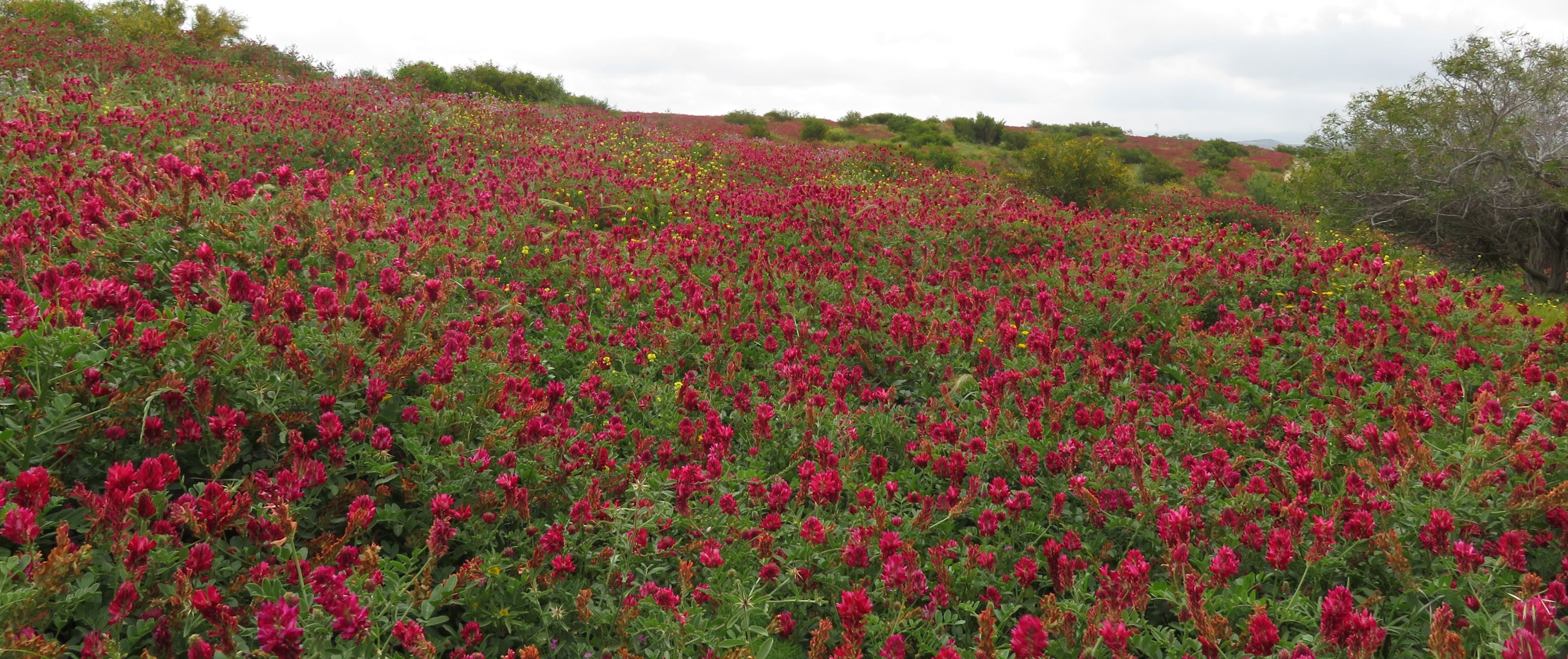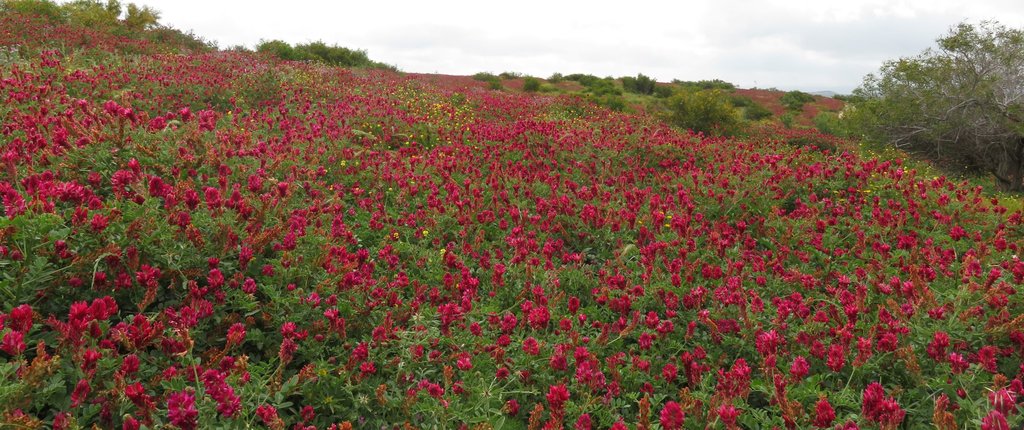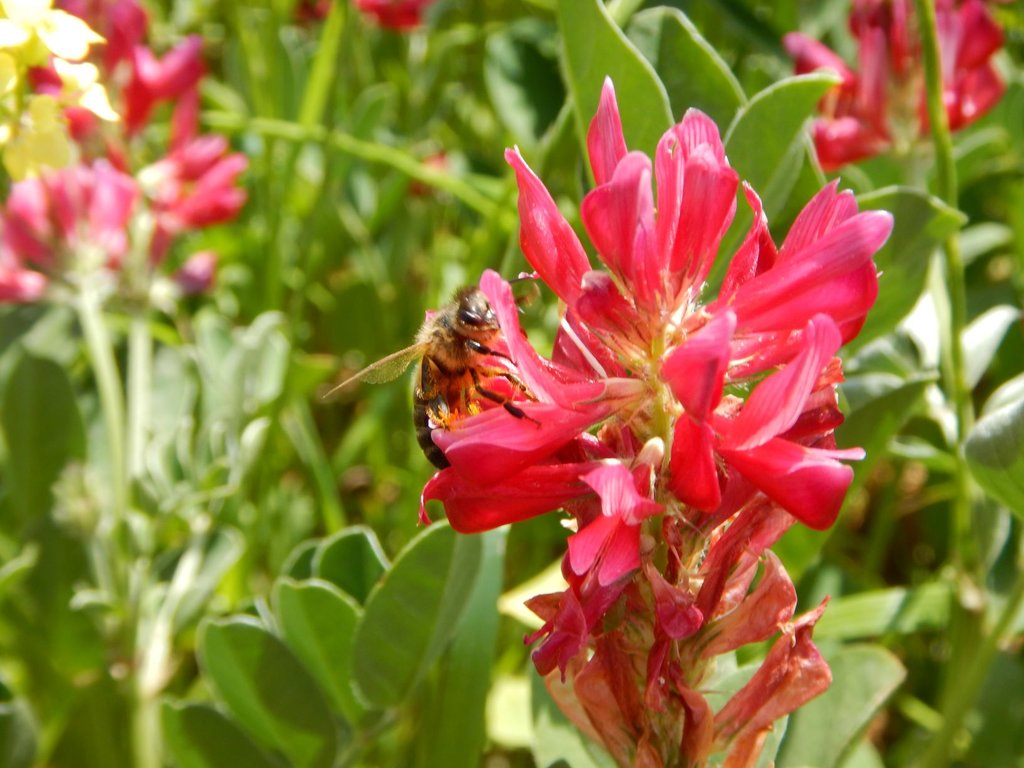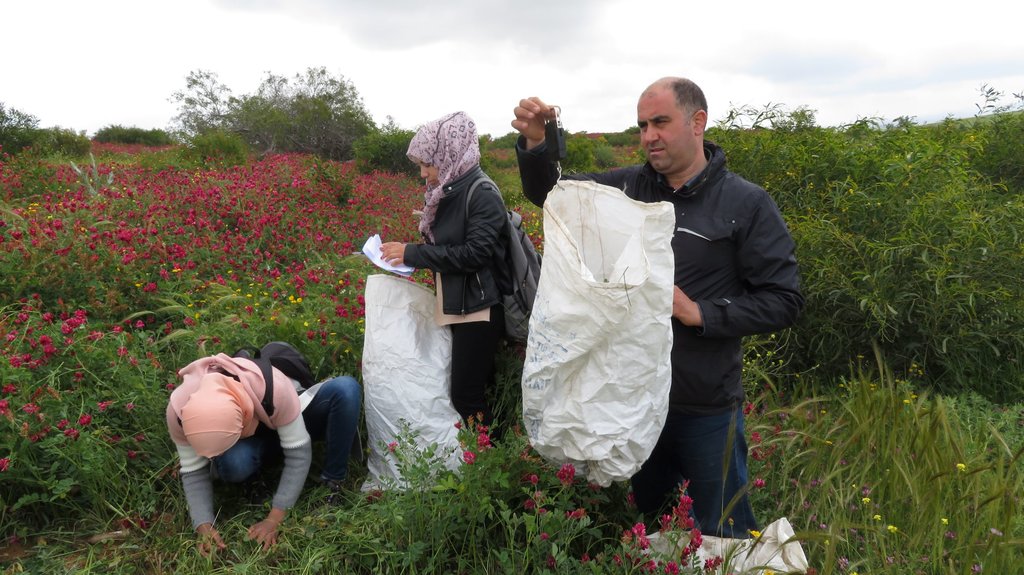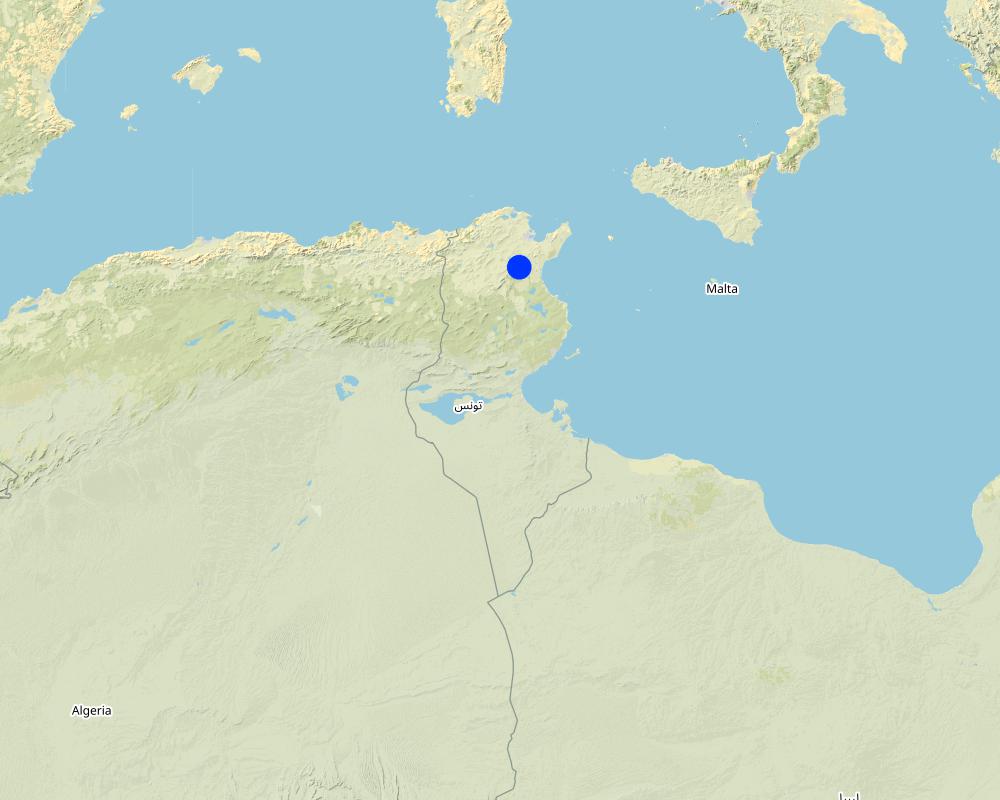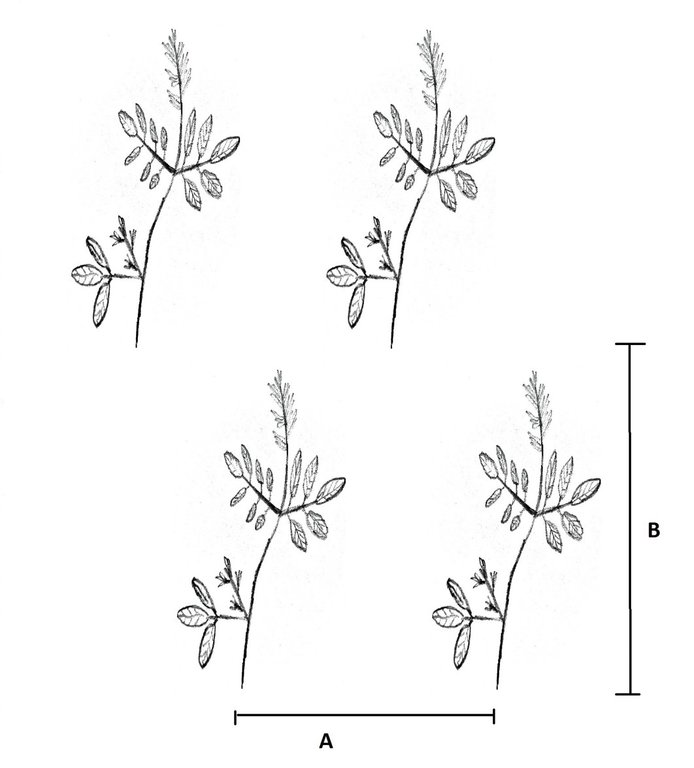Native Drought-Tolerant Forage Species for Enhanced Dryland Pasture Restoration [突尼斯]
- 创建:
- 更新:
- 编制者: Joren Verbist
- 编辑者: –
- 审查者: Rima Mekdaschi Studer, William Critchley
technologies_5919 - 突尼斯
查看章节
全部展开 全部收起1. 一般信息
1.2 参与该技术评估和文件编制的资源人员和机构的联系方式
关键资源人
Research Team Leader of Rangeland Ecology and Forages:
Louhaichi Mounir
International Center of Agriculture Research in the Dry Areas (ICARDA)
约旦
Associate Professor:
Slim Slim
School of Higher Education in Agriculture of Mateur
突尼斯
有助于对技术进行记录/评估的项目名称(如相关)
ICARDA Institutional Knowledge Management Initiative有助于对技术进行记录/评估的机构名称(如相关)
International Center for Agricultural Research in the Dry Areas (ICARDA) - 黎巴嫩1.3 关于使用通过WOCAT记录的数据的条件
编制者和关键资源人员接受有关使用通过WOCAT记录数据的条件。:
是
1.4 所述技术的可持续性声明
这里所描述的技术在土地退化方面是否存在问题,导致无法被认为是一种可持续的土地管理技术?:
否
2. SLM技术的说明
2.1 技术简介
技术定义:
The technology utilizes a drought-tolerant native forage legume, Hedysarium coronarium, to restore degraded soils by covering the soil, fixing nitrogen, improving biodiversity and increasing water infiltration while fodder quality and availability is improved.
2.2 技术的详细说明
说明:
In the semi-arid areas of Tunisia, drylands are prone to a harsh environment combining high temperatures and limited annual rainfall (350 - 600mm). Nevertheless, many marginal farmers depend on these drylands for income through grazing their livestock. However, due to worsening climatic conditions and mismanagement, the land is becoming seriously degraded. This results in a degradation cycle: overgrazing results in less land available to graze and therefore more rapid degradation on those areas. To break the cycle, an innovative approach is needed.
The International Centre of Agricultural Research in Dry Areas (ICARDA) recognized the problem and developed an approach, together with national parties Office de l'élevage et des pâturages (OEP), Office du Développement Sylvo- Pastoral du Nord -Ouest (ODESYPANO), and Direction Générale des forêts (DGF). They focused on native species which are adapted to the harsh environmental conditions. They selected leguminous species, because these enhance the soil's nutrient status through nitrogen fixation. Additionally, legumes improve the diet of livestock. The perennial Hedysarum coronarium or "Sulla" provides the soil with cover, reducing erosion and increasing water infiltration: rainfall is intercepted by the vegetation cover, resulting in less runoff. The cover also provides shade, which decreases evaporation. Then, the roots of the vegetation improve soil porosity, hence the infiltration capability of the soil. All these benefits improve biophysical and socio-economic resilience.
A degraded field was planted with Sulla in 2017. The land was ploughed before manual seeding. To prevent overgrazing, grazing was managed according to guidelines formulated by ICARDA and national parties. In the initial year, twenty-five smallstock (sheep/goats) graze one hectare for thirty to sixty days. In subsequent years, forty smallstock graze one hectare for thirty to sixty days, since the vegetation is then better rooted and developed. To maintain optimal production, a field needs reseeding after three years, hence the activities and related costs shown in this documentation are recurrent every three years.
This technology has had several positive impacts in the area. The productivity was increased from approximately 2310 kg (dry matter: DM) per hectare to approximately 5330 DM kg per hectare. The technology also increased water productivity from 9.5 DM kg per mm rainfall to 11.8 DM kg per mm rainfall. Hedysarum coronarium improved the quality of fodder, thus benefiting local land users. In addition, the soil was less prone to erosion and water better retained in the soil.
Land users also stated that they benefited from the improved fodder availability because this decreased the costs of feed import. Also, since Sulla is suited to the local climate, few inputs are required, reducing costs and work.
2.3 技术照片
2.5 已应用该技术的、本评估所涵盖的国家/地区/地点
国家:
突尼斯
区域/州/省:
Zaghouan Governorate
具体说明该技术的分布:
- 均匀地分布在一个区域
如果不知道精确的区域,请注明大致覆盖的区域:
- < 0.1 平方千米(10 公顷)
技术现场是否位于永久保护区?:
否
Map
×2.6 实施日期
注明实施年份:
2017
2.7 技术介绍
详细说明该技术是如何引入的:
- 在实验/研究期间
- 通过项目/外部干预
3. SLM技术的分类
3.1 该技术的主要目的
- 改良生产
- 减少、预防、恢复土地退化
- 降低灾害风险
- 适应气候变化/极端天气及其影响
- 创造有益的经济影响
3.2 应用该技术的当前土地利用类型
同一土地单元内混合使用的土地::
否

农田
- 多年一作(非木材)
- Hedysarum coronarium "Sulla"
每年的生长季节数:
- 1
采用间作制度了吗?:
否
采用轮作制度了吗?:
否

牧场
粗放式放牧:
- 半游牧畜牧业
动物类型:
- 山羊
- 绵羊
是否实行作物与牲畜的综合管理?:
否
品种:
绵羊
品种:
山羊
3.3 由于技术的实施,土地使用是否发生了变化?
由于技术的实施,土地使用是否发生了变化?:
- 是(请在技术实施前填写以下有关土地利用的问题)

不毛之地
具体说明:
Degraded lands
3.4 供水
该技术所应用土地的供水:
- 雨养
3.5 该技术所属的SLM组
- 畜牧业和牧场管理
- 改良的地面/植被覆盖
- 改良植物品种/动物品种
3.6 包含该技术的可持续土地管理措施

农艺措施
- A1:植被和土壤覆盖层
- A5:种子管理,改良品种

植物措施
- V2:草和多年生草本植物

管理措施
- M2:改变管理/强度级别
3.7 该技术强调的主要土地退化类型

土壤水蚀
- Wt:表土流失/地表侵蚀
- Wg:冲沟侵蚀/沟蚀

土壤风蚀
- Et:表土流失
- Ed:风蚀风积

化学性土壤退化
- Cn:肥力下降和有机质含量下降(非侵蚀所致)
- Cs:盐化/碱化

物理性土壤退化
- Pk:熟化和结壳
- Pi:覆土

生物性退化
- Bc:植被覆盖的减少
3.8 防止、减少或恢复土地退化
具体数量名该技术与土地退化有关的目标:
- 减少土地退化
- 修复/恢复严重退化的土地
4. 技术规范、实施活动、投入和成本
4.1 该技术的技术图纸
技术规范(与技术图纸相关):
The average plant density is 120 per square metre. This relates to the following spacing:
Space within rows (A) = 9 centimeter
Space between rows (B) = 9 centimeter
作者:
Joren Verbist
日期:
07/07/2021
4.2 有关投入和成本计算的一般信息
具体说明成本和投入是如何计算的:
- 每个技术区域
注明尺寸和面积单位:
1 Hectare
具体说明成本计算所用货币:
- 美元
注明雇用劳工的每日平均工资成本:
7
4.3 技术建立活动
| 活动 | 时间(季度) | |
|---|---|---|
| 1. | Land Preparation | |
| 2. | Seeding |
4.4 技术建立所需要的费用和投入
| 对投入进行具体说明 | 单位 | 数量 | 单位成本 | 每项投入的总成本 | 土地使用者承担的成本% | |
|---|---|---|---|---|---|---|
| 劳动力 | Manual Seeding | Person-Hours | 10.0 | 0.875 | 8.75 | 100.0 |
| 设备 | Plough | Machine-Hours | 0.75 | 15.0 | 11.25 | 100.0 |
| 植物材料 | Sulla Seed | Kilogram | 30.0 | 1.5 | 45.0 | |
| 技术建立所需总成本 | 65.0 | |||||
| 技术建立总成本,美元 | 65.0 | |||||
如果土地使用者负担的费用少于100%,请注明由谁负担其余费用:
The seeds are often provided by other parties such as ICARDA or national parties
注释:
The activities and related costs are recurrent every 3 years.
5. 自然和人文环境
5.1 气候
年降雨量
- < 250毫米
- 251-500毫米
- 501-750毫米
- 751-1,000毫米
- 1,001-1,500毫米
- 1,501-2,000毫米
- 2,001-3,000毫米
- 3,001-4,000毫米
- > 4,000毫米
农业气候带
- 半干旱
5.2 地形
平均坡度:
- 水平(0-2%)
- 缓降(3-5%)
- 平缓(6-10%)
- 滚坡(11-15%)
- 崎岖(16-30%)
- 陡峭(31-60%)
- 非常陡峭(>60%)
地形:
- 高原/平原
- 山脊
- 山坡
- 山地斜坡
- 麓坡
- 谷底
垂直分布带:
- 0-100 m a.s.l.
- 101-500 m a.s.l.
- 501-1,000 m a.s.l.
- 1,001-1,500 m a.s.l.
- 1,501-2,000 m a.s.l.
- 2,001-2,500 m a.s.l.
- 2,501-3,000 m a.s.l.
- 3,001-4,000 m a.s.l.
- > 4,000 m a.s.l.
说明该技术是否专门应用于:
- 不相关
5.3 土壤
平均土层深度:
- 非常浅(0-20厘米)
- 浅(21-50厘米)
- 中等深度(51-80厘米)
- 深(81-120厘米)
- 非常深(> 120厘米)
土壤质地(表土):
- 中粒(壤土、粉土)
土壤质地(地表以下> 20厘米):
- 中粒(壤土、粉土)
表土有机质:
- 中(1-3%)
如有可能,附上完整的土壤描述或具体说明可用的信息,例如土壤类型、土壤酸碱度、阳离子交换能力、氮、盐度等。:
(47% silt, 29% sand and 24% clay)
5.4 水资源可用性和质量
地下水位表:
5-50米
地表水的可用性:
匮乏/没有
水质(未处理):
不良饮用水(需要处理)
水质请参考::
地下水
水的盐度有问题吗?:
是
该区域正在发生洪水吗?:
否
5.5 生物多样性
物种多样性:
- 高
栖息地多样性:
- 中等
5.6 应用该技术的土地使用者的特征
定栖或游牧:
- 半游牧的
生产系统的市场定位:
- 混合(生计/商业)
非农收入:
- 收入的10-50%
相对财富水平:
- 非常贫瘠
- 贫瘠
个人或集体:
- 个人/家庭
机械化水平:
- 手工作业
- 机械化/电动
性别:
- 男人
土地使用者的年龄:
- 青年人
- 中年人
- 老年人
5.7 应用该技术的土地使用者使用的平均土地面积
- < 0.5 公顷
- 0.5-1 公顷
- 1-2 公顷
- 2-5公顷
- 5-15公顷
- 15-50公顷
- 50-100公顷
- 100-500公顷
- 500-1,000公顷
- 1,000-10,000公顷
- > 10,000公顷
这被认为是小规模、中规模还是大规模的(参照当地实际情况)?:
- 小规模的
5.8 土地所有权、土地使用权和水使用权
土地所有权:
- 个人,未命名
- 个人,有命名
土地使用权:
- 个人
用水权:
- 社区(有组织)
- 个人
土地使用权是否基于传统的法律制度?:
是
5.9 进入服务和基础设施的通道
健康:
- 贫瘠
- 适度的
- 好
教育:
- 贫瘠
- 适度的
- 好
技术援助:
- 贫瘠
- 适度的
- 好
就业(例如非农):
- 贫瘠
- 适度的
- 好
市场:
- 贫瘠
- 适度的
- 好
能源:
- 贫瘠
- 适度的
- 好
道路和交通:
- 贫瘠
- 适度的
- 好
饮用水和卫生设施:
- 贫瘠
- 适度的
- 好
金融服务:
- 贫瘠
- 适度的
- 好
6. 影响和结论性说明
6.1 该技术的现场影响
社会经济效应
生产
饲料生产
饲料质量
生产故障风险
收入和成本
农业投入费用
农业收入
工作量
生态影响
水循环/径流
地表径流
蒸发
土壤
土壤水分
土壤覆盖层
土壤流失
土壤堆积
土壤结壳/密封
养分循环/补给
盐度
生物多样性:植被、动物
植被覆盖
生物量/地上C
植物多样性
减少气候和灾害风险
干旱影响
微气候
6.3 技术对渐变气候以及与气候相关的极端情况/灾害的暴露和敏感性(土地使用者认为的极端情况/灾害)
渐变气候
渐变气候
| 季节 | 增加或减少 | 该技术是如何应对的? | |
|---|---|---|---|
| 年温度 | 增加 | 好 |
气候有关的极端情况(灾害)
气候灾害
| 该技术是如何应对的? | |
|---|---|
| 热浪 | 好 |
| 干旱 | 好 |
6.4 成本效益分析
技术收益与技术建立成本相比如何(从土地使用者的角度看)?
短期回报:
非常积极
长期回报:
非常积极
技术收益与技术维护成本/经常性成本相比如何(从土地使用者的角度看)?
短期回报:
非常积极
长期回报:
非常积极
6.5 技术采用
- 单例/实验
6.6 适应
最近是否对该技术进行了修改以适应不断变化的条件?:
否
6.7 该技术的优点/长处/机会
| 土地使用者眼中的长处/优势/机会 |
|---|
| Decreased costs of feed import |
| Better year-round availability of fodder |
| Less risk of drought damage |
| 编制者或其他关键资源人员认为的长处/优势/机会 |
|---|
| Enhanced soil conditions such as improved soil moisture and fixed nitrogen |
| Improved economic situation of local land users |
| Restoration of degraded land |
6.8 技术的弱点/缺点/风险及其克服方法
| 土地使用者认为的弱点/缺点/风险 | 如何克服它们? |
|---|---|
| Grazing management | Grazing management ensures sustainable fodder production hence it is a necessary sacrifice. |
7. 参考和链接
7.1 信息的方法/来源
- 与SLM专业人员/专家的访谈
- 根据报告和其他现有文档进行编译
7.2 参考可用出版物
标题、作者、年份、ISBN:
Mounir Louhaichi, Slim Slim, Khlifa Jilali. (30/11/2020). Field day on sulla cultivation using a participatory community-based approach.
可以从哪里获得?成本如何?
https://hdl.handle.net/20.500.11766/12367
标题、作者、年份、ISBN:
Slim Slim, Mounir Louhaichi, Mouldi Gamoun, Serkan Ates, Sawsan Hassan, Oumeima Rhomdhane, Azaiez Ouled Belgacem. (17/2/2021). Assessment of soil surface scarification and reseeding with sulla (Hedysarum coronarium L. ) of degraded Mediterranean semi-arid rangelands. African Journal of Range and Forage Science.
可以从哪里获得?成本如何?
https://hdl.handle.net/20.500.11766/12618
标题、作者、年份、ISBN:
Mounir Louhaichi, Kailene Jamel, Slim Slim, Med Bechir Tarchi, Mouldi Gamoun, Sawsan Hassan, Hloniphani Moyo. (30/4/2019). Sustainable Silvopastoral Restoration to Promote Ecosystem Services in Tunisia Project Final Report.
可以从哪里获得?成本如何?
https://hdl.handle.net/20.500.11766/10220
标题、作者、年份、ISBN:
Mounir Louhaichi, Slim Slim, Gouider Tibaoui. (14/9/2018). Managing rangelands: promoting sustainable legume species: Hedysarum coronarium L. a biennial herbaceous legume used for forage in the Mediterranean basin. Beirut, Lebanon: International Center for Agricultural Research in the Dry Areas (ICARDA).
可以从哪里获得?成本如何?
https://hdl.handle.net/20.500.11766/8497
链接和模块
全部展开 全部收起链接
无链接
模块
无模块


